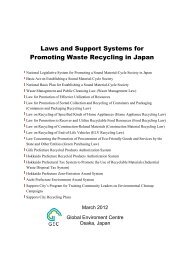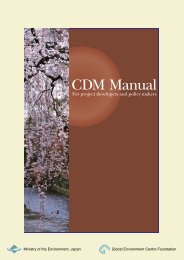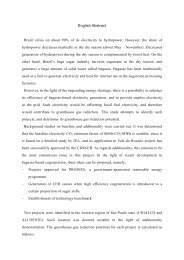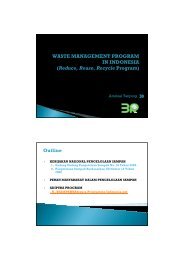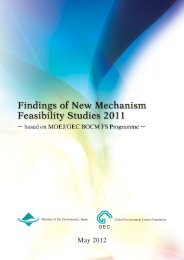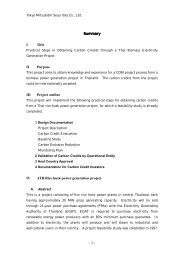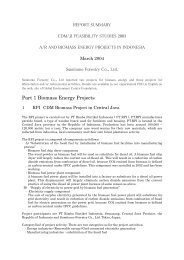PDF File - GEC
PDF File - GEC
PDF File - GEC
Create successful ePaper yourself
Turn your PDF publications into a flip-book with our unique Google optimized e-Paper software.
The three types of project activities outlined above are mutually exclusive. In a project activity with<br />
more than one component that will benefit from the simplified modalities and procedures for SSC<br />
project activities, each component shall meet the threshold criterion of each applicable type, e.g.<br />
for a project with both a renewable energy and an energy efficiency component, the renewable<br />
energy component shall meet the criterion for “Type I: renewable energy” and the energy efficiency<br />
component shall meet that for “Type II: energy efficiency improvement”.<br />
2.2.4 Additionality in small scale CDM (SSC)<br />
A simplified baseline and monitoring methodology listed in Appendix B of Annex II to Decision 21/<br />
CP.8 (FCCC/CP/2002/7/Add.3) may be used for a SSC project activity if the project participants are<br />
able to demonstrate to a DOE that the project activity would otherwise not be implemented due<br />
to the existence of one or more of the barriers listed below. Project participants shall provide an<br />
explanation to show that the project activity would not have occurred anyway due to at least one of<br />
the following barriers:<br />
(a) Investment barrier: a financially more viable alternative to the project activity would have led<br />
to higher emissions;<br />
(b) Technological barrier: a less technologically advanced alternative to the project activity<br />
involves lower risks due to the performance uncertainty or low market share of the new<br />
technology adopted for the project activity and so would have led to higher emissions;<br />
(c) Barrier due to prevailing practice: prevailing practice, existing regulatory, or policy<br />
requirements would have led to implementation of a technology with higher emissions;<br />
(d) Other barriers: without the project activity, for another specific reason identified by the<br />
project participant, such as institutional barriers or limited information, managerial resources,<br />
organizational capacity, financial resources, or capacity to absorb new technologies, emissions<br />
would have been higher.<br />
It may be mentioned here that the EB has agreed to a compilation of non-binding best practice<br />
examples to demonstrate additionality [EB35, Annex 34] to assist the development of PDDs for<br />
small scale CDM project activities, which incorporates public inputs and an analysis of additionality<br />
in registered SSC project activities. A general guidance to the SSC methodologies is available [EB41,<br />
Annex 20].<br />
2.2.5 Approved small scale CDM (SSC) methodologies<br />
Approved methodologies for SSC project activities, which are listed in Appendix 2, are part of the<br />
Appendix B of the simplified modalities and procedures for small scale CDM project activities<br />
[decision 4/CMP.1, Annex II].<br />
Project participants may propose changes to the simplified baseline and monitoring methodologies<br />
or propose additional project categories for consideration by the EB. Project participants willing to<br />
submit a new small scale CDM project activity category or revisions to a methodology shall make<br />
a request in writing to the EB providing information about the technology/activity and proposals<br />
on how a simplified baseline and monitoring methodology would be applied to this category. The<br />
EB shall expeditiously, if possible at its next meeting, review the proposed methodology. All new<br />
proposed small scale methodologies submissions undergo a desk review prior to consideration by<br />
the EB [EB34, para. 26]. Once approved, the EB shall amend the indicative list of simplified baseline<br />
and monitoring methodologies contained in Appendix B.<br />
29




